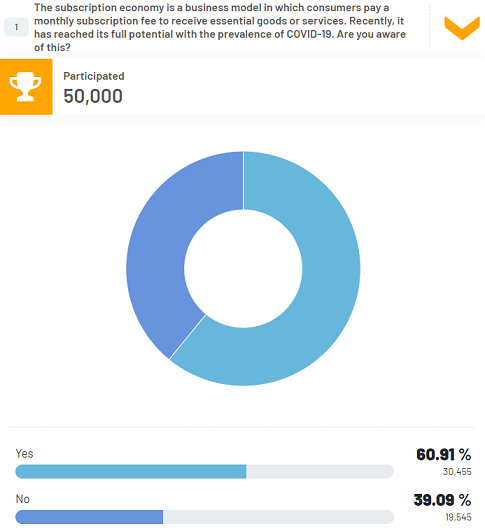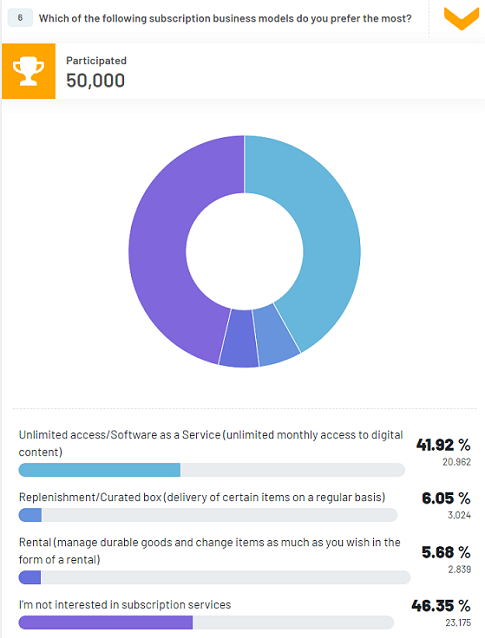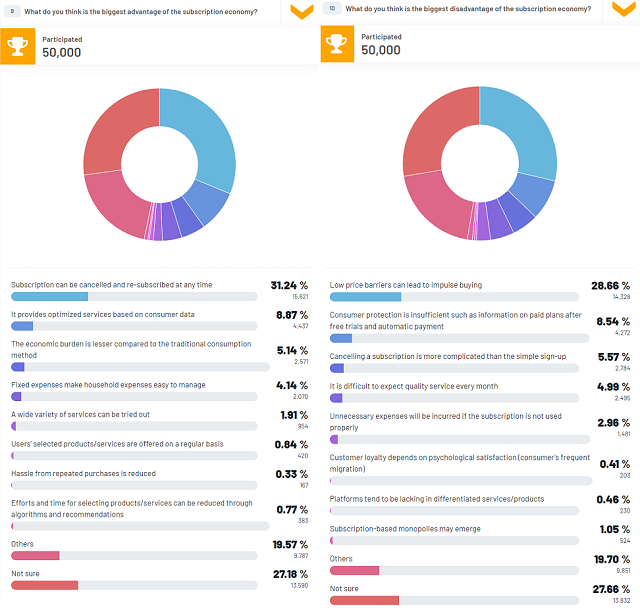 41.92% Prefer the Unlimited Access Type of Subscription Business Model
41.92% Prefer the Unlimited Access Type of Subscription Business ModelThe subscription economy is another new business model that is also gaining popularity. Much like the gig and sharing economy, it seems that the subscription economy is also disrupting many industries.
Thus, the Real Research online survey app decided to garner public view on this fast-growing subscription economy trend. For instance, is the public really satisfied with the subscription business model? Here are the results.
Highlights
- The majority are already using services with subscription economy models
- 41.92% prefer the unlimited access type of subscription model
- Respondents pick main advantages and disadvantages of the subscription economy
Many Are Already Using Services With the Subscription Economy Model
To begin, Real Research first asked if the respondents are aware of the subscription economy business model. In particular, 60.91% said that they are aware of it.

Next, the survey went on to ask the respondents a series of questions to see if they are using services with this subscription economy business model. In order, the survey asked if the respondents are subscribed to Netflix, YouTube Premium, Amazon Prime, and Spotify.
Accordingly, Netflix got 52.87% ‘Yes’ and YouTube Premium got 50.41% ‘Yes’. Meanwhile, Amazon Prime got 50.87% ‘Yes’ and Spotify got 46.99% ‘Yes’.
Read Also: Statista Poll: Netflix Tops World’s Subscription Streaming Services
Most Prefer Unlimited Access Type Subscription Business Model
Carrying forth, the survey asked respondents which subscription business model they prefer the most. Here, the majority (41.92%) said unlimited access/software as a service (unlimited monthly access to digital content).
Following after, 6.05% said replenishment/curated box (delivery of certain items on a regular basis). Lastly, 5.68% said rental (manage durable goods and change items as much as you wish in the form of a rental).

The respondents next chose reasons for why they choose to use subscription services. It seems that the biggest reason to adopt a subscription economy is that respondents simply wished to try something new (25.19%).
Likewise, 8.76% say they were recommended to do so while 5.39% say due to convenience. Meanwhile, 5.34% say easy accessibility and affordability, 5.11% say economic benefits, and 3.19% say payment is fast and automatic.
Specifically, the survey asks if respondents are satisfied with the subscription economy service that they are currently using. The answers came ‘Extremely satisfied’ (26.54%), ‘Satisfied’ (12.21%), ‘Neutral’ (16.94%), ‘Unsatisfied’ (4.35%), and ‘Extremely unsatisfied’ (2.6%).
The Pros and Cons of Subscription Economy
Next, the survey asks what the respondents would say is an advantage of the subscription economy. The majority (31.24%) liked the no-commitment aspect of it. To specify, they like that subscription can be canceled anytime and also re-subscription can be done anytime.
In addition, 8.87% like that it provides optimized services based on consumer data and 5.14% feel the economic burden is lesser compared to the traditional consumption method. Meanwhile, 4.14% said fixed expenses make household expenses easy to manage and 1.91% say a variety of experiences can be tried out.
In contrast, they also chose the disadvantages of the subscription economy. The majority (28.66%) say low price barriers can lead to impulsive buying. Then, 8.54% say consumer protection is inefficient and 5.57% say the cancellation process is complicated. Lastly, 4.99% say it is hard to expect quality monthly services and 2.98% say unnecessary expenses are made if the services aren’t used properly.

Finally, when asked if the respondents would like to continue using their subscription economy services, 57.57% say ‘Yes’.
Methodology | |
| Survey Title | Public Perception on Subscription Economy |
| Duration | November 01 – November 8, 2021 |
| Number of Participants | 50,000 |
| Demographics | Males and females, aged 21 to 99 |
| Participating Countries | Afghanistan, Algeria, Angola, Argentina, Armenia, Australia, Azerbaijan, Bahrain, Bangladesh, Belarus, Benin, Bolivia,… Brazil, Brunei, Bulgaria, Burkina Faso, Cambodia, Cameroon, Canada, Chile, China, China (Hong Kong) China (Macao), China (Taiwan), Colombia, Costa Rica, Croatia, Czech Republic, Ecuador, Egypt, El Salvador, Ethiopia, Finland, France, Gambia, Georgia, Germany, Ghana, Greece, Greanada, Guatemala, Honduras, Hungary, India, Indonesia, Iraq, Ireland, Israel, Italy, Ivory Coast, Japan, Jordan, Kenya, Kuwait, Kyrgyzstan, Latvia, Lebanon, Libya, Lithuania, Malaysia, Maldives, Maluritania, Mexico, Moldova, Mongolia, Morocco, Mozambique, Myanmar [Burma], Namibia, Nepal, Nicaragua, Nigeria, Oman, Pakistan, Palestine, Panama, Peru, Philippines, Poland, Portugal, Qatar, Romania, Russia, Saudi Arabia, Serbia, Sierra Leone, Singapore, Slovakia, South Africa, South Korea, Spain, Sri Lanka, Tanzania, Thailand, Togo, Tunisia, Turkey, Turkmenistan, Uganda, Ukraine, United Arab Emirates, United Kingdom, United States, Uruguay, Uzbekistan, Venezuela, Vietnam, Yemen, Zimbabwe. |
RR Author
Real Research News is the media platform that presents insights and studies of wide-range of topics. It focuses on insights gathered from its survey app.







